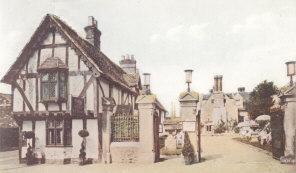We start in the south of the District with the Almshouses close by to Mapledurham House on the River Thames. The group of six Almshouses was built in 1613 as a memorial to Sir Charles Lister. At some recent time they have been converted into two cottages.
Heading northwards we come to the marvelous Henry Alnut Almshouses, founded in 1724 in Goring Heath. This photo is the first Almshouse picture I took with my (then) new Lumix camera.

The central building is the chapel.
Now we head east to Henley-on-Thames to see the Barnaby Cottages, New Street. They were given by William Barnaby in 1582 bu later divided into 5 cottages in 1788. They were restored in 1928, 1972 and 2000.
Near to the church are the Almshouses provided by John Longland, Bishop of Lincoln in 1517 and rebuilt in 1830.
Heading west we come to Wallingford where Angier's Almshouses can be found on the Reading Road. They were founded by William Angier and his sister Mary in 1681.
We head north to reach Ewelme. The Duke and Duchess of Suffolk spent a good deal of time in Ewelme and
set about creating a model village. In 1437 Henry VI licensed them
to build an Almshouse - "God's house in Ewelme" - for 13 poor men and
two clerks. The original statute demanded that the inmates, donning a
habit,
attend daily church services, including Mass and Evensong, and to pray
for the souls of their benefactors in the Chapel. This is the imposing entrance.
And here is a couple of views of the Cloister.
Our last destination in South Oxfordshire is Thame. In 1447 Richard Quartermain and his wife Sibyl founded a chantry or Guild of St Chroistopher. This was replaced by the current building in the 16th century. The Almshouses were sold in the 19th century and the money used to provide a yearly allowance to each of the almspeople. The house is now privately owned. Below is a historical picture.

And this is what it looks like now.
We conclude this review in Oxford City, which has surprisingly few Almshouses. The only one in fact is Stone's Almshouses near St Clements.

The plaque says:
This Hospital for ye Poor & Sick
was founded by
The Reverend Mr WILL. STONE
Principal of New Inne Hall
in Hopes
of thy Assistance.
Ao.Dni. 1700
In the 1960s the architect Thomas Rayson added an extension to each side: Parson's Almshouses on the left (1960) and Mary Duncan Almshouses on the right (1964). The one on the left was paid for by Helen and Frank Altschul of New York City so that University College could take over the original Parsons Almshouse in Kybald Street.
It seems now to be integrated into College accommodation and is indeed where Bill Clinton stayed when he was a Rhodes scholar.










No comments:
Post a Comment